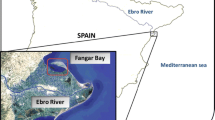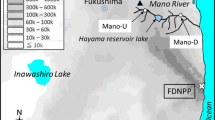Abstract
The elimination of 3 radionuclides from Euphausia pacifica was measured over a 5 month period. The biological half-lives for 65Zn, 137Cs, and 144Ce, calculated after the euphausiids had ingested radioactive Artemia nauplii, were found to be 140 days, 6 days, and 7.5 h, respectively. The percentages of body burdens lost in molts were greatest for the fission products, 144Ce (21%) and 137Cs (7%), and least for 65Zn (1%). Elimination of the isotopes in the feces could not be followed because of the difficulty in collecting fecal material for analysis; however, 1 sample collected 2 months after the beginning of the elimination experiment had no measurable radioactivity. Loss of 65Zn from molts and time to disintegration of the molts were found to be temperature dependent over a 5° to 15°C range, and the sinking rate of molts was both temperature and salinity dependent. Calculations showed that, in areas in the North Pacific outside the influence of upwelling, percentage 65Zn loss from sinking molts (before disintegration of the molts) was likely to be the same throughout the year, since the molts would be exposed to about the same mean temperature in the water column in all seasons. Even though temperature structure in the upper layers changes with season, mean temperatures change very little when calculated over the sinking distance of intact molts. Intact molts would sink to slightly over 400 m in the absence of turbulence, and would lose 87% of their 65Zn by the time they reached this depth. Sinking molts thus might contribute substantially to the vertical transport of 65Zn in the sea. If loss of 65Zn in fecal pellets is assumed to be small under our experimental conditions, and molting loss is only 1% of 65Zn body burden, the major mechanism of 65Zn loss from euphausiids feeding on non-radioactive food must be isotopic exchange with the water. Approximately 96% of the initial body burden was eliminated over a period of 5 months.
Similar content being viewed by others
Literature cited
Baptist, J. P. and D. E. Hoss: Accumulation and retention of radionuclides by marine fish. Ann. Rep. Bur. comm. Fish. Radiobiol. Lab., Beaufort, N.C., June 30, 1963. Circ. Fish Wildl. Serv., Wash. 204, 14–19 (1965).
Boden, B. P., M. W. Johnson and E. Brinton: The Euphausiacea (Crustacea) of the North Pacific. Bull. Scripps Instn Oceanogr. tech. Ser. 6, 287–398 (1955).
Bowen, H. J. M.: Trace elements in biochemistry, 241 pp. London: Academic Press 1966.
Bowen, V. T., J. S. Olson, C. L. Osterberg and J. Rivrba: Ecological interactions of marine radioactivity. In: Radioactivity in the marine environment, Washington D.C.: National Academy of Sciences, National Research Council (In press).
Brinton, E.: The distribution of Pacific euphausiids. Bull. Scripps Instn Oceanogr. tech. Ser. 8, 51–271 (1962).
Broecker, W., F. D. Goldberg, M. G. Gross and K. K. Turekian: Chemistry section. In: Radioactivity in the marine environment, Washington D.C.: Nat. Acad. Sciences, Nat. Res. Council. (In press).
Bryan, G. W.: Ionic regulation in the squat lobster Galathea squamifera with special reference to the relationship between potassium metabolism and the accumulation of radioactive caesium. J. mar. biol. Ass. U.K. 45, 97–115 (1965).
—E. Ward: Potassium metabolism and the accumulation of caesium-137 by decapod crustaceans. J. mar. biol. Ass. U.K. 42, 199–241 (1962).
Chipman, W. A.: Accumulation of radioactive materials by fishery organisms. Proc. Gulf Caribb. Fish. Inst. 11, 97–110 (1958).
Cross, F. A.: Behaviour of certain radionuclides in a marine benthic amphipod. Ph. D. Thesis, 64 pp. Oregon State University 1968.
Cross, F. A., J. M. Dean and C. L. Osterberg: The effect of temperature, sediment and feeding on the behavior of four radionuclides in a marine benthic amphipod. In: Symposium on radioecology, Proceedings of the Second National Symposium, pp 450–461. Ed. by D. J. Nelson and F. C. Evans. USAEC-CONF-670503 1969.
Fowler, S. W. and L. F. Small: Molting of Euphausia pacifica as a possible mechanism for vertical transport of zinc-65 in the sea. Int. J. Oceanol. Limnol. 1, 237–245 (1967).
Fowler, S. W., L. F. Small and J. M. Dean: Metabolism of zinc-65 in euphausiids. In: Symposium on radioecology, Proceedings of the Second National Symposium. pp 391–411. Ed. by D. J. Nelson and F. C. Evans. USAEC-CONF-670503 1969.
—Distribution of ingested zinc-65 in the tissues of some marine crustaceans. J. Fish. Res. Bd Can. 27, 1051–1058 (1970).
Fowler, S. W., L. F. Small and S. Kečkeš: Effects of temperature, size, and species on molting of euphausiid crustaceans. (In preparation).
Jerde, C. W. and R. Lasker: Molting of euphausiid shrimp: shipboard observations. Limnol. Oceanogr. 11, 120–124 (1966).
Kuenzler, E. J.: Elimination of iodine, cobalt, iron, and zinc by marine zooplankton. In: Symposium on Radioecology, Proceedings of the Second National Symposium. pp 462–473. Ed. by D. J. Nelson and F. C. Evans. USAEC-CONF-67503 1969.
Lasker, R.: Feeding, growth, respiration and carbon utilization of a euphausiid crustacean. J. Fish. Res. Bd Can. 23, 1291–1317 (1966).
Lowman, F. G., T. R. Folsom, T. R. Rice and F. Richards: Accumulation and redistribution of radionuclides by marine organisms. In: Radioactivity in the marine environment, Washington D.C.: Nat. Acad. Sciences, Nat. Res. Council. (In press).
Mauchline, J. and L. R. Fisher: The biology of euphausiids. Adv. mar. Biol. 7, 1–454 (1969).
Osterberg, C. L.: Fallout radionuclides in euphausiids. Science, N.Y. 138, 529–530 (1962).
—H. Curl, Jr.: Acceleration of sinking rates of radionuclides in the ocean. Nature, Lond. 200, 1276–1277 (1963).
—W. Pearcy: Zinc-65 in euphausiids as related to Columbia River water off the Oregon coast. Limnol. Oceanogr. 9, 249–257 (1964a).
—H. Curl, Jr.: Radioactivity and its relationship to oceanic food chains. J. mar. Res. 22, 2–12 (1964b).
Paranjape, M. A.: Molting and respiration of euphausiids. J. Fish. Res. Bd Can. 24, 1229–1240 (1967).
Pearcy, W. G. and C. L. Osterberg: Depth, diel, seasonal, and geographic variations in zinc-65 of midwater animals off Oregon. Int. J. Oceanol. Limnol. 1, 103–116 (1967).
Pequegnat, J. E., S. W. Fowler and L. F. Small: Estimates of the zinc requirements of marine organisms. J. Fish. Res. Bd Can. 26, 145–150 (1969).
Renfro, W. C.: Radioecology of 65Zn in arm of the Columbia River estuary. Ph. D. Thesis, 88 pp. Oregon State University 1968.
Rice, T. R.: Accumulation of radionuclides by aquatic organisms. In: Studies of the fate of certain radionuclides in estuarine and other aquatic environments, pp 35–50. Ed. by J. L. Sabo and P. H. Bedrosian, Washington, D.C.: U.S. Dept. of Health, Education and Welfare, Publ. Health Service 1963.
Small, L. F.: Experimental studies on the transfer of 65Zn in high concentration by euphausiids. J. exp. mar. Biol. Ecol. 3, 106–123 (1969).
Williams, L. G. and Q. Pickering: Direct and food chain uptake of cesium-137 and strontium-85 in bluegill fingerlings. Ecology 42, 205–206 (1961).
Wolfe, D. A.: Zinc enzymes in Crassostrea virginica. J. Fish. Res. Bd Can. 27, 59–69 (1970).
Author information
Authors and Affiliations
Additional information
Communicated by J. M. Peres, Marseille
Supported by USAEC research contract AT (45-1)1830, PHS grant ES00026, and a Richland Graduate Fellowship to S. W. Fowler.
Rights and permissions
About this article
Cite this article
Fowler, S.W., Small, L.F. & Dean, J.M. Experimental studies on elimination of zinc-65, cesium-137 and cerium-144 by euphausiids. Marine Biology 8, 224–231 (1971). https://doi.org/10.1007/BF00355220
Accepted:
Issue Date:
DOI: https://doi.org/10.1007/BF00355220




